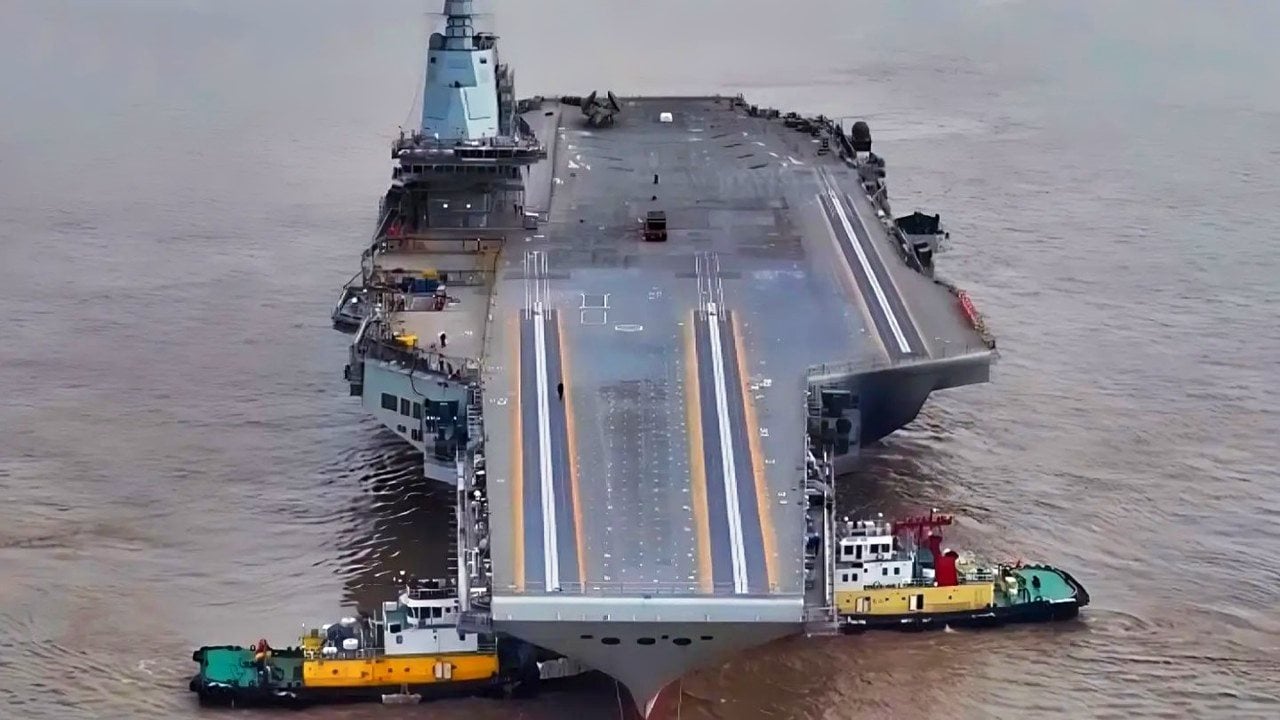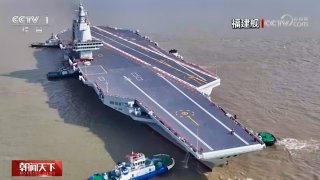Fujian: China's Plan to Have 6 Aircraft Carriers by 2035
China's People's Liberation Army Navy (PLAN) Type 003 Fujian, the country's largest aircraft carrier, completed its second sea trial this week and returned to the Jiangnan Shipyard in Shanghai.
Summary and Key Points: China's People's Liberation Army Navy (PLAN) Type 003 Fujian, the country's largest aircraft carrier, completed its second sea trial this week and returned to the Jiangnan Shipyard in Shanghai.

-The 80,000-ton vessel spent 20 days at sea, conducting propulsion system tests in the Yellow Sea, including sharp turns and sailing maneuvers.
-The trials were kept under wraps, and future tests will include its weapon systems and electromagnetic catapults, with aircraft launch and recovery tests expected later this year.
-The Type 003 is projected to enter service by 2026. China's carrier program aims to have six carriers by 2035, closing the gap with the U.S. Navy.
Chinese state media outlets have reported the People's Liberation Army Navy (PLAN) Type 003 Fujian completed its second sea trial earlier this week and returned to the Jiangnan Shipyard in Shanghai. The warship, China's third and largest aircraft carrier, spent 20 days at sea, beginning on May 23.
The 80,000-ton vessel was deployed to the Yellow Sea, where the propulsion system was put to the test. According to the Global Times – which cited the Singtao Daily – this included "sharp turning and sailing."
The second sea trials were not announced in advance, so the PLAN is clearly trying to keep its cards close to its chest. Fujian's first set of sea trials, conducted earlier this spring took place in the East China Sea, closer to its shipyard in the port of Shanghai. That was expected as Beijing wouldn't have wanted the vessel to be far from home should any mishap occur.
More Tests Coming
The Yellow Sea was reportedly selected for the second round of sea trials due to the large number of PLAN training bases in the region, and likely as it is "relatively closed off," making it harder for the U.S. or other nations to conduct reconnaissance. The waters of the Yellow Sea had been previously used for the aircraft testing of the Type 001 Liaoning – and there has been speculation that aircraft tests could be coming soon on the Type 003 Fujian.
However, the aircraft carrier will need to be put through the paces on a number of other tests first, and that will include its weapon systems, and then its electromagnetic catapults. But the first aircraft launch and recovery could still take place later this year.
However, the Type 003 Fujian will not enter service until at least 2026. As USNI News reported earlier this year, the Type 002 ShandongChina's first domestically built carrierconducted nine sea trials from May 2018 to November 2019, and that warship wasn't exactly a great leap forward in design. It was largely based on the Type 001, which was laid down as a Soviet aircraft cruiser before being sold by Ukraine to China.
The number of new systems will require significant testing, and there are likely plenty of bugs to be worked out. Yet, the pace of China's carrier program is notable given that just over a decade ago the PLAN was only refurbishing the Type 001. Beijing is now seeking to close the gap with the U.S. Navy and has set a goal of having six carriers in service by 2035.
In addition to greater capabilities, the Type 003 is among the largest carriers in the world.

The conventionally powered Type 003 displaces 80,000 metric tons, dwarfing the PLAN's two active carriers, the 66,000-ton Type 002 Shandong and the 60,000-ton Type 001 Liaoning. Only the U.S. Navy's Nimitz-class and Gerald R. Ford-class nuclear-powered supercarriers are larger, with the former class displacing around 87,000 metric tons, and the newer Ford class displacing 100,000 metric tons.
Author Experience and Expertise: Peter Suciu
Peter Suciu is a Michigan-based writer. He has contributed to more than four dozen magazines, newspapers, and websites with over 3,200 published pieces over a twenty-year career in journalism. He regularly writes about military hardware, firearms history, cybersecurity, politics, and international affairs. Peter is also a Contributing Writer for Forbes and Clearance Jobs. You can follow him on Twitter: @PeterSuciu. You can email the author: [email protected].
All images are Creative Commons.


